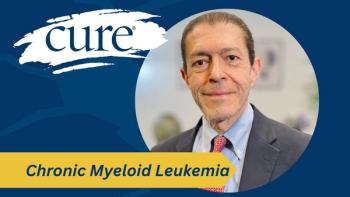
Expert Discusses Stem Cell Research and Personalizing Lung Cancer Care
During an interview with CURE, Desai, an assistant professor of medicine at Stanford Medicine, shared insight on his research in stem cells and why discovering which cells have the potential to form lung cancer is significant to the treatment paradigm.
Tushar Desai, MD
Can subpopulations of cells go on to develop into lung cancer? Emerging research is investigating to find out.
“It is an exciting time in cancer research; there is a saying going around that ‘it is the beginning of the end of cancer,’” said Tushar Desai, M.D. “It is really the ability to use these modern genetic tools to figure out the mutations and the cells, and then develop ways to target those mutations in a really personalized manner. Everyone has heard the term, ‘precision health’ or ‘personalized medicine.’ We are hopefully in a new era where we can start, one by one, to come up with good or even curative treatments for advanced cancer—for a variety of types.”
You discussed stem cell research. What are some of the highlights you can mention?
During an interview with CURE, Desai, an assistant professor of medicine at Stanford Medicine, shared insight on his research in stem cells and why discovering which cells have the potential to form lung cancer is significant to the treatment paradigm.My focus was on the very early stages of lung cancer development by asking, which cells are capable of forming cancer? Are all cells capable of forming cancer, or only a subset? I have been doing some work in basic lung biology, and identifying the stem cells that regenerate new cells during aging and after injury. It turns out that there are specialized subpopulations that can execute this activity and not all the lung cells can.
Our idea is that these cells, which are intrinsically better at proliferating, dividing and generating new cells, are more easily hijacked and they can form tumors more easily than other cells. It could be that they are exclusively capable of forming tumors and that other cells can’t. So, we are doing a variety of experiments using environmental exposures to induce cancer in mice, and we are trying to mark these different cell populations beforehand and asking, “Which are the ones that are susceptible to forming cancer?”
Is this similar to the concept of chimeric antigen receptor (CAR) T-cell therapy, in which we would manipulate these stem cells for them to have changed characteristics?
The summary points of my talk are that not all cells in the lung are equal, in terms of their ability to generate cancer. If we can identify which ones are the most at risk, then that can help us perhaps with diagnostic treatments or trying to prevent cancer. On the flip side, if we can identify what makes the other cells not vulnerable to forming cancer, maybe we can try to figure out what they are doing to be resistant to forming cancer—in order to think about targeting those pathways for treatment of cancer. Yes, I think so. It is quite likely that different cell types can give rise to the same kind of cancer. For example, there is lung adenocarcinoma. If it came from one type of lung cell versus another — if you just look at the histology — they both look like adenocarcinoma. However, if you can figure out that they came initially from a different cell site, then you can try to ask what intrinsic capacity does the one cell type have versus the other. And, you can think of treatments to target those special abilities.
Therefore, it is looking at what the mutation does, and how the mutation makes the cell divide. It is sort of saying, “OK, what is this cell naturally capable of doing?” as well as targeting those pathways, which are different than in another cell. It could also be that if they generated from a different cell site they could express different markers, so it’s possible you could target those markers using some sort of antibody-mediated treatment to eradicate them. Those are the kinds of things.
How is this approach being implemented now?
There is a lot to be learned from looking at the cells that do not form cancer. It seems…that some cells are resistant and KRAS, for instance, is very hard to target pharmacologically. Therefore, if we know that this cell has something downstream that prevents KRAS from making it a prolific form of cancer, we need to figure out what that is. They are sort of biologically inspired therapies—looking at what nature naturally does and then trying to emulate it. A lot of this work is done in mice, where we will give a carcinogen and then we take advantage of a strategy called genetic cell-type making, lineage tracing or fate mapping; there are different names for this. With this technology, it allows you to permanently, undoubtedly, and heritably mark a certain cell. You can say, “I’m going to take all type 2 cells, ciliated cells or basal cells, and I’m going to make them turn out and express a fluorescent protein in a color.” Because of their power of these genetic tools, once you activate the fluorescent protein in those cells, they won’t turn it off, no matter what happens to them.
For example, some of the work we have been doing is marking different cells like club cells, type 2 cells, and basal cells. Then, we give this carcinogen, we watch the tumors and we ask, “Did they express the fluorescent protein?” If they do, then we know that tumor derived from the cell type that we originally marked. Therefore, it’s a very powerful way, and an unbiased way, that we are going to expose all the cells to the carcinogen.
Then, we’re [going to] ask, “Is it overrepresented [with] a certain type of cell, a type II cell?” If 90 percent of the time the cancer is from the type 2 cell, then that would really be informative. Then, we can look at the type 2 cell and say, “How is that different from a cell that is resistant to the carcinogen?”
If we see a certain percentage of the time that the cancers arise from several different cell types, then that is very useful because then we can try to find a way, in the mature tumor in the human, where you can’t do this marking. Can we say there is a way to say which cell was the one that gave rise to the tumor? If we do that, then we can think about that cell and what that cell is intrinsically capable of doing and can’t do, and try to modulate that.
What are the challenges with this kind of research?
It’s nice because, conceptually, it’s very simple, It’s not very complicated. It’s good because a lot of cancer biology is focused on looking at the cancer and what’s driving it. That is great for figuring out how to block the cancer but, if we can figure out how these cells can prevent the cancer so much so that you would never find them because they just don’t form cancer, but if we can identify them and figure out what’s special about them, then it is a good opportunity.It is hard to know with confidence how similar or different cancer in a mouse is from cancer in humans. Let’s say that we identify some principles about cancer and how we can control it in mice. It’s not a given that that is going to be the same [principle] in humans.
We are also trying to progressively move more toward studying human cells, and so we've got some collaborations [ongoing]. We are actually able to take normal human cells, isolate them, put them in culture and get them to grow a lot. This is actually a big breakthrough; we are getting ready to submit a paper on this, and people have been trying to do this for a long time and they haven’t been successful. With collaborators, we found a way to make this happen, so now we are really excited about taking these human cell populations and introducing the cancer-causing mutations.
Then, we see what they do in the dish and we try to transplant them into a mouse…then that is going to shed a lot of light because we are going to be able to say we took a type II cell from a human and we put in a KRAS mutation, and we did the same thing with club cells and basal cells. Then, we would ask, “Are all or some of them able to form an adenocarcinoma?” That is going to be a beautiful experiment because, since you can’t retrospectively figure out which cell the cancer came from, it’s going to be a way to figure it out—eliminate certain cells and implicate others and say, “OK, this is likely the cell that gave rise to the cancer.”





